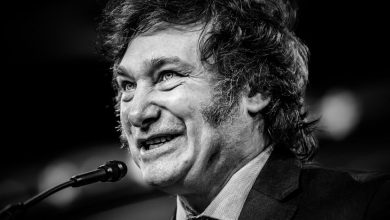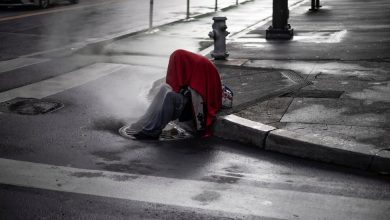The Ukrainians Who Choose to Stay

Good morning. It’s Wednesday. Today we’ll look at the pushback Ukrainian New Yorkers get when they try to persuade their older relatives to flee Ukraine. And on a lighter note, we’ll check out the New Yorkiest new/old jewelry line you can imagine.

Liza Gutina, who lives in Brooklyn, can’t persuade her uncle to leave southern Ukraine.Credit…Misha Friedman for The New York Times
The arguments are happening all over New York City and its suburbs. Over WhatsApp, waiting anxiously for replies, people of Ukrainian descent are cajoling, haranguing and begging their relatives to leave the Ukrainian cities and towns that are under Russian attack.
More than four million Ukrainians have left their homeland since Russia invaded. But some of the New Yorkers encounter stubborn resistance from older family members overseas, my colleague Kimiko de Freytas-Tamura learned when she spoke to members of the Ukrainian community in the New York area.
Reasons for staying are explained patiently but firmly to younger relatives. There is pride, or a sense of duty to face down Russia, or simply a love for home. There is hope and rationalization. There is distaste for arduous journeys and unfamiliar destinations.
“If I left, I don’t know where I’m going. I don’t know how I’m going to survive this journey,” Ludmila Steblina, 83, countered when she was invited to travel to Queens from Kharkiv, where a bomb blew out the balcony windows in her apartment two weeks ago. “If I need to go to the bathroom, who will I ask for help?”
Olga Lubchenko, in Kramatorsk in Ukraine’s east, assured her son in Hoboken, N.J., that a local oligarch would keep her safe. Her husband, Taras, simply forwarded a winking emoji — and instructions for firing an antitank missile.
Tetiana Guzik, 53, keeping her spirits up during a ban on alcohol sales with a buzz from cherry-liqueur bonbons, told her niece in Queens, “Stop being hysterical and go take your meds.”
A universal process
Their responses reflect a culture common to those who lived under the former Soviet Union: Older people — survivors of war, Stalinism and state collapse — are not easily intimidated. Grandmothers, or babushki, are famously formidable.
“It’s the relatives in Ukraine who are trying to reassure the ones in New York,” de Freytas-Tamura said.
But there is also something universal at work. In every war I’ve covered — Syria, Iraq, Afghanistan and more — the choice to stay or go is deeply individual and divides families. There are always people like Guzik, who previously were driven from a home and are refusing to flee again, or the Lubchenko, whose beloved garden makes life worth living.
Even after close calls, and even after horrific reports like the recent revelations of atrocities in towns that Russians had occupied, many stay. To survive, they are wired to adapt.
Maybe fiction captures it best. In Mohsin Hamid’s novel “Exit West,” a couple builds their marriage as war gradually unbuilds their unnamed society. One bomb is shocking; frequent ones become background noise. Soon it seems normal to dodge bullets on the way to get groceries.
When staying is your only weapon
Alexander, 65, a mathematician in Kherson, told a niece in Brooklyn he was used to Russians arresting his neighbors for protesting. He was like someone going about normal life in a sci-fi movie, he said: “You know the aliens are there, and every so often, they steal people and then give them back.”
Ultimately, some conclude staying is their sole power. A Syrian once told me government forces had destroyed his family and home but couldn’t take his country. Palestinians call this steadfastness, or “sumood.” President Volodymyr Zelensky of Ukraine, speaking to his country on the eve of the invasion, put it this way: “We are here.”
“Somebody has to keep the roots here,” Guzik told her niece.
Recently, the alcohol ban lifted for a few hours. Guzik had snagged a bottle of her favorite red wine and was saving it, she said, for the victory.
Weather
Prepare for rain early in the day, with winds gusts and a chance of showers in the afternoon. Temps will be in the mid-50s, dropping to the high 40s at night, with more rain possible late.
alternate-side parking
In effect until April 14 (Holy Thursday).
The latest New York news
-
Dominic Taddeo, the fearsome hit man from upstate New York who walked away from a Florida halfway house last week, was recaptured “without incident.”
-
A 61-year-old woman was fatally shot in the Bronx, caught in the crossfire after two groups of men began arguing nearby with guns drawn.
-
The Supreme Court ruled in favor of a Brooklyn man who said he had been falsely accused by police officers of resisting arrest.
How a haul of gems became sustainable jewelry
In his 91 years, Vito Giallo — son of a bootlegger, one-time gallerist and assistant to Andy Warhol, and antique dealer to luminaries like Mark Rothko and Robert Mapplethorpe — has taken part in one New York cultural era after another.
So it may be fitting that he is now part of another evolution. Like so many creative New Yorkers, during the pandemic he started something new — this time far from his antique shop on Madison Avenue. Tapping into a Brooklyn-centric scene, he came up with a zeitgeisty product, sustainable and locally sourced and dripping with New Yorkiness.
As Kate Dwyer wrote in the Times Style section, that product is a line of jewelry called Catbird x Vito’s Gems, a collaboration with Catbird, a Brooklyn-based company that specializes in creations from recycled gems.
Russia-Ukraine War: Key Developments
U.N. meeting. President Volodymyr Zelensky of Ukraine addressed the United Nations Security Council, detailing the horrors he saw in Bucha, the Kyiv suburb where Russian troops have been accused of killing civilians, and laying out a powerful indictment of the U.N.’s failure to prevent the invasion.
Russian atrocities. The growing evidence that civilians in Bucha had been killed purposely and indiscriminately by Russian soldiers spurred calls by Western leaders to hold Russia accountable. A Times analysis of satellite imagery refuted claims by Russia that the killings occurred after its soldiers had left.
Pushing for more sanctions. The images from Bucha prompted the European Commission to propose new measures against Russia, including a ban on coal imports. The United States started blocking Russia from making debt payments using dollars held in American banks.
On the ground. As Russian forces have retreated around Kyiv, Ukrainian and Western officials said that Russia appeared to be positioning troops for an intensified assault in the eastern Donbas region, where the port city of Mariupol remains under a brutal siege.
In this case, the stones are from a hoard that Giallo, in his antique-hunting days, said he found in disintegrating envelopes in the messy apartment of an obscure gem dealer just as the building superintendent was about to clear everything away. There were thousands of amethysts, rubies, emeralds, topaz, opals and moonstones.
Giallo had fallen out with Warhol in his youth, but later the artist became a frequent customer in his antiques store and bought a few gems. Giallo put the rest away in storage. But his great-grandniece, who works at a sustainability start-up, persuaded him to find a collaborator to make something out of them.
Catbird’s website calls the collection “an ode to the luminous life of a quintessential New Yorker,” and you really have to read the whole piece. In it, Giallo takes us back to 1950s New York, where you could dine exquisitely for $1.85 — about $22 today — look for a “lighting guy” in Lord & Taylor and come up with Alexander Calder’s best friend and, as Giallo put it, “sleep in Central Park without worrying that you were in danger.”
What we’re reading
-
Make art and live on an island for free? That’s the idea behind a new artist residency program, TimeOut New York reports.
-
Eater reported on how people in New York City are seeking group and communal-style dining in restaurants and pop-ups.
-
Brooklyn Magazine photographed the opening of Luna Park in Coney Island, a signal of the start of the summer amusement park season.
METROPOLITAN diary
‘Free chocolates!’
Dear Diary:
It was around 1952. I was 10, and I liked it that my family had to change from the downtown D to the local AA at West Fourth Street.
The vertical I-beams on the platform there had vending machines that dispensed miniature Suchard chocolate bars for a penny a pop.
I always pulled on the little plungers to see if chocolate bars would appear magically without the requisite pennies.
One day, ta-da!: The plungers on all four machines were not working, and I was filling my pockets with free chocolates just as the local pulled into the station.
As I got on the train with my family, I saw another boy approaching.
“Free chocolates!” I yelled, pointing to one of the machines. “It’s jammed!”
As we pulled away in the direction of Spring Street, I was happy to see the other boy busily “milking” the machine at a furious pace.
— Giulio Maestro
Illustrated by Agnes Lee. Send submissions here and read more Metropolitan Diary here.
Glad we could get together here. See you tomorrow. — A.B.
P.S. Here’s today’s Mini Crossword and Spelling Bee. You can find all our puzzles here.
Melissa Guerrero, Jeff Boda and Ed Shanahan contributed to New York Today. You can reach the team at [email protected].
.





